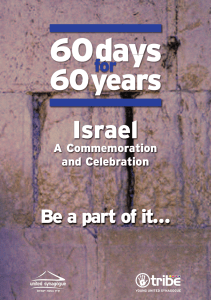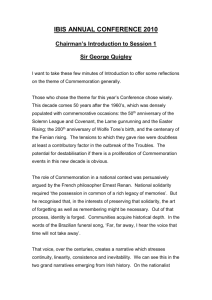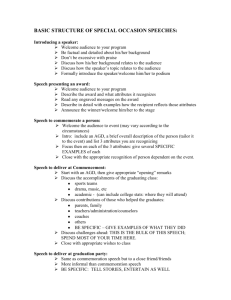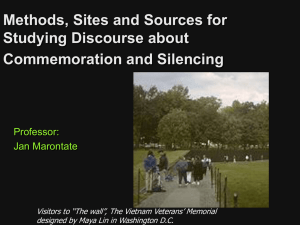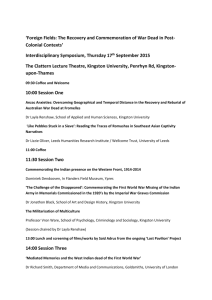Document 12630391
advertisement
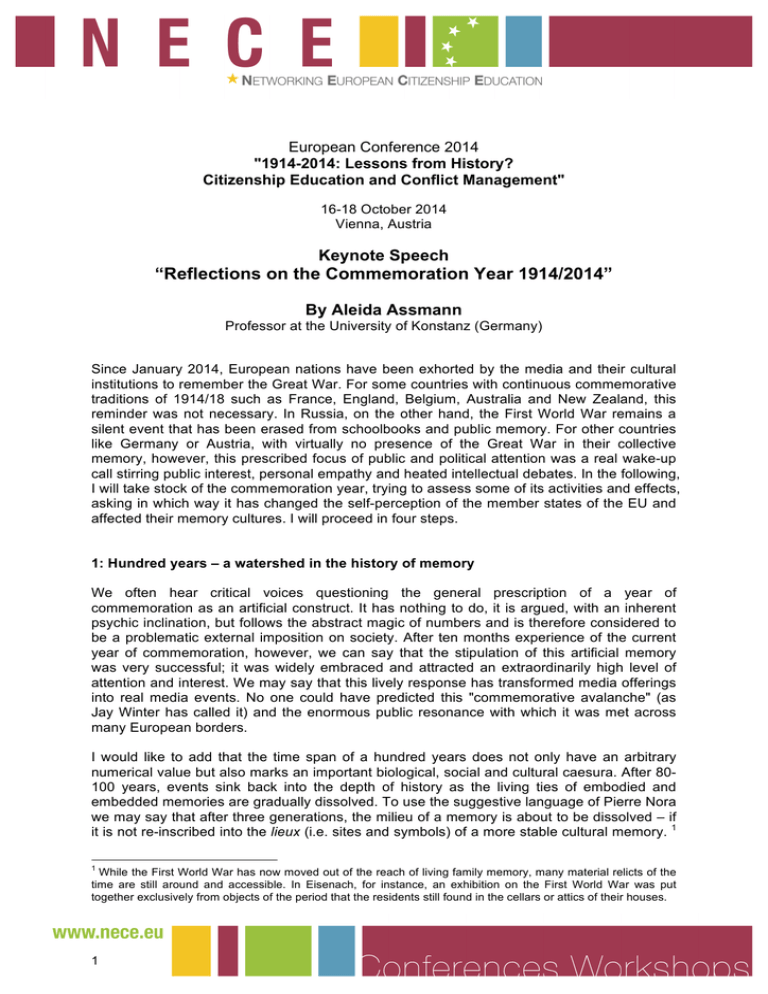
European Conference 2014 "1914-2014: Lessons from History? Citizenship Education and Conflict Management" 16-18 October 2014 Vienna, Austria Keynote Speech “Reflections on the Commemoration Year 1914/2014” By Aleida Assmann Professor at the University of Konstanz (Germany) Since January 2014, European nations have been exhorted by the media and their cultural institutions to remember the Great War. For some countries with continuous commemorative traditions of 1914/18 such as France, England, Belgium, Australia and New Zealand, this reminder was not necessary. In Russia, on the other hand, the First World War remains a silent event that has been erased from schoolbooks and public memory. For other countries like Germany or Austria, with virtually no presence of the Great War in their collective memory, however, this prescribed focus of public and political attention was a real wake-up call stirring public interest, personal empathy and heated intellectual debates. In the following, I will take stock of the commemoration year, trying to assess some of its activities and effects, asking in which way it has changed the self-perception of the member states of the EU and affected their memory cultures. I will proceed in four steps. 1: Hundred years – a watershed in the history of memory We often hear critical voices questioning the general prescription of a year of commemoration as an artificial construct. It has nothing to do, it is argued, with an inherent psychic inclination, but follows the abstract magic of numbers and is therefore considered to be a problematic external imposition on society. After ten months experience of the current year of commemoration, however, we can say that the stipulation of this artificial memory was very successful; it was widely embraced and attracted an extraordinarily high level of attention and interest. We may say that this lively response has transformed media offerings into real media events. No one could have predicted this "commemorative avalanche" (as Jay Winter has called it) and the enormous public resonance with which it was met across many European borders. I would like to add that the time span of a hundred years does not only have an arbitrary numerical value but also marks an important biological, social and cultural caesura. After 80100 years, events sink back into the depth of history as the living ties of embodied and embedded memories are gradually dissolved. To use the suggestive language of Pierre Nora we may say that after three generations, the milieu of a memory is about to be dissolved – if it is not re-inscribed into the lieux (i.e. sites and symbols) of a more stable cultural memory. 1 1 While the First World War has now moved out of the reach of living family memory, many material relicts of the time are still around and accessible. In Eisenach, for instance, an exhibition on the First World War was put together exclusively from objects of the period that the residents still found in the cellars or attics of their houses. 1 This means that with respect to World War I, we have arrived at a temporal watershed, where the event will recede into the past. Thereafter, either it will be of interest only to historians, or it will have to be actively reconstructed and supported along new lines. After 100 years, in other words, we are not only looking back at the history of the events, but we are also looking into the future of their memory, considering the possibility of their reconstruction and perpetuation. This future-oriented aspect of memory is more than the mere preservation and continuation of what has been transmitted. It involves a new interpretation of historic events together with new social emotions and political commitment in the present. Moving from short-term communicative memory to long-term cultural memory urges states and nations to rethink practices, to re-establish standards and to construct new foundations for the future. This is exactly what is happening in the commemoration year: we are witnessing a temporal watershed at which memories of World War I are recycled, restaged, probed, reconstructed and transformed for the future. 2: The temporal and spatial extension of European memory Within the memory frame of the European Union, the new focus and emphasis on World War I effected an important prolongation of the horizon of the common European past. The shots in Sarajevo triggered what is commonly referred to as the "great seminal catastrophe" (or Urkatastrophe) of the twentieth century (George Kennan). 2 It started a traumatic concatenation of cataclysmic events unleashing unprecedented violence involving the Russian Revolution, another World War and the Holocaust. A new discourse about Europe started only after World War II. The EU was thus founded on the premises that came out of World War II, choosing the Universal Declaration of Human Rights in 1948 and the Holocaust as the defining elements of the war's common legacy and the Union's identity. In the course of the commemoration year, however, we could witness how the temporal and spatial frame of European history and memory was enlarged. It is now the entangled European history of violence spanning the whole twentieth century that is taken into account. This extension concerns not only the temporal frame but also applies to the dimension of space. While the EU started small, with an economic association between France and Germany that more and more countries joined, the over all destruction of Europe started big, changing national borders and effecting deep transformations in the geopolitical landscape. Nor was it only a material battle introducing new mechanical weapons of mass destruction, but a battle that involved the drafting of all the warring countries' fathers, uncles and sons. The clashing of five empires also had global repercussions, involving the forced commitment of thousands of colonial soldiers. The history of Europe is therefore intimately connected with global history. The rise of a new small Europe was built on the demise of an old colonial Europe. 3: Divided national memories of the Great War What first became obvious at the beginning of the year of commemoration were the striking differences in national memory. It has often been emphasized that the First World War was for the Germans very different from La Grande Guerre for the French and the Great War for the English. In France the last surviving veterans were buried one after another with military pomp and circumstance in a countdown that was heeded by the whole population and attracted much media attention. In German national memory the name "Versailles" remained for a long time the placeholder for this war.3 It was bound up with a memory of guilt, shame 2 Kennan, George F. 1979. The decline of Bismarck's European Order: Franco-Russian Relations, 1875 - 1890. Princeton, NJ: Princeton Univ. Press, p. 3 3 Etienne Francois and Hagen Schulze, art. Versailles in Deutsche Erinnerungsorte 2 and an unrespectable peace. For this reason, the First World War never really ended in the minds and hearts of many Germans, who prepared themselves for a subsequent war that was to give them back everything they had lost in terms of territories, pride and self-image. The French and English came out of the war in 1918 with totally different feelings. Although they had been victorious, they were deeply demoralized and traumatized. Nor have they waited for a hundred years to officially commemorate this event. This war is commemorated every year in France, England and Belgium, but also in New Zealand and Australia. In Europe the commemoration day is 11 November, the day of the Armistice in 1918 at the Western Front. In England it is observed with poppies and two minutes of silence, one for the dead, one for their families. On the same day the Germans celebrate the opening of their carnival season – a striking example for cultural variety within Europe. They also observe a public day of mourning, but the First World War is not a topic on this occasion. Their memory of the First World War was buried under the memory of the Second World War and that memory was buried under the memory of the Holocaust. Do not get me wrong: neither world war was ever forgotten by the generations involved. They were the incisive, lasting and traumatic key events of the respective cohorts and became the nucleus of a rich literature. They also received the form of a national narrative into which grandfathers, fathers and sons inscribed their memories and transmitted them to their children. Given the way in which it was instrumentalised in Nazi politics, this heroic national narrative was no longer acceptable after 1945. It is true that the names of fallen soldiers of the Second World War were added to the names inscribed into the monuments of the First World War. That which no longer had a symbolic place in national memory was thus preserved for a while in the local memory of towns, villages and communities. When the year of commemoration began, Germans were eager to join the bandwagon and catch up with a forgotten or neglected phase of their national history. While a country like Germany is currently in search of its lost historical past and therefore welcomes a new European edition of its national non-memory, other memories of the Great War are becoming even more national. 4: Creating a new National Memory for the Future – The case of the United Kingdom My example for the construction of a new national memory is a speech by British Prime Minister David Cameron on 11 October 2012. He gave this speech at the Imperial War Museum, which was transformed to become "the centrepiece" of British commemorations of the Great War. With this transformation, Cameron hoped that "new generations will be inspired by the incredible stories of courage, toil and sacrifice".4 He also referred to the watershed of public memory, conceding that the living memory of the Great War had vanished and that his own family memory dates back only to World War II. But he asserted: "I passionately believe we should hold on to this heritage and pass it down the generations." Such a statement is more easily proclaimed than executed and implemented. Cameron, however, meant it. He confirmed that 50 million pounds had been committed to the year of commemoration. As a consequence of which, he had to answer the following: "why should we make such a priority of commemorations when money is tight and there is no one left from the generation that fought the Great War?" In his answer, Cameron named "the scale of the sacrifice", "the length and scale of the trauma", its historical significance and the enduring 4 David Cameron, "Speech at Imperial War Museum on First World War centenary plans", 11 October 2012, www.gov.uk/government/speeches/speech-at-imperial-war-museum-on-first-world-war-centenary-plans. All subsequent quotations of the speech are from this official transcript. 3 emotional bond to the event, all summed up in the assertion that "there is something about the First World War that makes it a fundamental part of our national consciousness." In his speech, Cameron made a concrete pledge. He promised to build "an enduring cultural and educational legacy [...] to ensure that the sacrifice and service of a hundred years ago is still remembered in a hundred years' time". It is indeed the national narrative of "sacrifice" and "service" that is at the heart of the "truly national commemoration" that Cameron promised to construct and perpetuate.5 He explicitly named and honoured all the colonial troops, inviting them into the inclusive "We" of British national memory, thus constructing a post-imperial memory for these troops rather than a dialogic post-colonial memory with their new nations. While Cameron expressed a massive concern for the past, there is little concern in his speech for contemporary allies and constellations. New ties with other European nations are not mentioned. On the contrary, his post-imperial national memory looks more like a veto against the possibility of a shared, or at least connected, European memory of the Great War. 5: The Great War as a European memory? Many activities during the commemoration year transcended national borders, stirring common interest and public debates. There was a host of media presentations in various formats including films, documentaries and docu-dramas that brought World War I back to general attention. A prominent example were the book and TV series entitled 14 – Diaries of the Great War that retell the big history from the small but emotionally engaging point of view of personal stories across national borders. It is based on 14 diaries of male and female, military and civil, known and unknown persons from France, Russia, Australia, the United States, Germany, Austria and the United Kingdom.6 The format focuses less on the historical events as such than on individual stories and the emotions of the protagonists, which can easily be shared by viewers today across national borders. "For the first time", the producer argues, "the war is being presented from a multinational perspective".7 Historical scholarship has also contributed to a trans- or multi-national memory in the commemoration year 1914/2014. Since January 2014 we have been flooded with new presentations of World War I by international historians. The undisputed transnational bestseller of the commemoration year is Christopher Clark's The Sleepwalkers: How Europe went to War in 1914. 8 Born in Sydney in 1960, Clark belongs to a new generation of historians. His presentation of the primal catastrophe of World War I emerges from the perspective of an Australian who is linked to this event by two family memories, that of his own grandfather fighting in the British colonial Australian and New Zealand Army Corps (ANZAC) and that of his wife's grandfather fighting on the side of the Germans. His reasoning is consistently pragmatic, resisting the constraints of a narrative that selects and combines events to make a clear statement. Clark's innovation consists in producing a "thick 5 The term “truly national commemoration” is mentioned four times in his speech. In 2010 an international team of researchers and authors had started to work on this project in the archives, sifting through more than 1.000 diaries and collections of letters. The print version, which soon became a bestseller, was transformed into a TV series. Events recorded in the diaries were recast by modern actors and interspersed with historical instruction and archival materials consisting of photos and historical film footage of the time. 7 In a digital media extension, 14 was also offered on the Internet as a multimedia Webspecial that made it possible for users to further interact with the film and the historical material. Interactive navigation through the series makes it possible to compare the different timelines of the 14 protagonists, thus discovering personal, national and cultural differences and similarities in this transnational framework. 8 (London Allen Lane 2012; German translation: Die Schlafwandler - Wie Europa in den Ersten Weltkrieg zog (München: DVA 2013). 6 4 description" by following a strictly comparative method. Every position and assessment is countered by information showing that very little at the time was specific to only one nation. He thus discovers similarities where previously the search for differences had structured the entangled cluster of facts. We learn much from his book about the historical perspective of the French, Britons, Russians, Austrians and Germans, but we get to know them all as Europeans. That which they have in common is much more significant than that which separates them. In spite of the criticism of some of his colleagues, Clark's book was welcomed in 2014, because it provides European nations with a common historical frame that can accommodate different perspectives, such that their stories can be continue to be remembered but no longer in opposition to one other. Summary To conclude: the 1914/2014 year of commemoration is not only an artificial construction but also something of a Rorschach test. It brings to the fore common European values and shared emotions, but also divisive national traumas, anxieties and ongoing concerns. It offers the chance of a shared recognition of a traumatic entangled history of violence and suffering out of which the victors emerged traumatized and the defeated were infected with resentful heroism. Given this multiplicity of perspectives, it is more than doubtful whether there will ever be a European master narrative of World War I. Even though heroic narratives are still around, what has been emerging during the last months is an empathic awareness of individual life stories across national borders, shared grief and a common facing of senseless suffering. European memory is growing longer and more inclusive; below the ashes of the concentration camps Europeans are rediscovering in the killing fields and cemeteries of Ypres and Verdun another common point of reference and origin. Perhaps the great chance for Europeans in the commemoration year – and this might well constitute a course in European citizenship too – lies in the possibility to learn more about their own and other countries' memories. Learning more about each other's memories could be the European way to arrive at a common framework that might overcome or at least contain the divisive quality of national memories. 5
